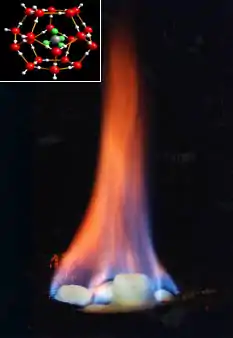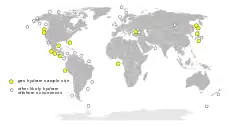Hydration number
The hydration number, or solvation number of a compound is defined as the average number of molecules bound to the compound more strongly (by 13.3 kcal/mol or more) than they are bound to other water molecules.[1] The hydration number is dependent on the concentration of the compound in solution, and the identity of the compound. When compounds are dissolved in water, the water molecules form a solvation shell surrounding the solute. For charged species, the orientation of water molecules around the solute is dependent on its ionic charge,[2] with cations attracting water’s electronegative oxygen and anions attracting the hydrogens. Uncharged compounds such as methane can also be solvated by water and also have a hydration number. Although solvation shells can contain inner and outer shell solvent-solute interactions, the hydration number generally focuses on the inner shell solvent molecules that most directly interact with the solute.[3]

Background
Given the overwhelming abundance of liquid water found in biological systems and the high prevalence of dissolved ionic species, understanding the behavior of ions in solution is critical. Ions in solution must overcome not only the preferred entropic state of disordered water molecules in order to form a solvation shell, but also the powerful hydrogen bonding interactions found between water molecules. Attraction between the solute ion and water increases with the solute’s electric charge and decreases with its radius. Hydration number estimates are not limited to integer values (for instance, estimates for sodium include 4, 4.6, 5.3, 5.5, 5.6, 6, 6.5, and 8), with some of the spread of estimated values being due to differing detection methods.[4]
Determination of hydration number
Hydration numbers can be determined using a variety of different experimental methods. These include Raman spectroscopy,[5] neutron and X-ray scattering,[6] luminescence,[7] and NMR.[8] Hydration numbers can change depending on whether the species is locked into a crystalline lattice form or free flowing in solution. The apparent hydration number of a species can vary depending on which experimental method was used.[4] Large alkali metal cations in particular, very common throughout nature and in biological systems, remain unreliably characterized.[9]
Methane clathrates

Methane (CH4) is the simplest hydrocarbon compound. Although it is relatively hydrophobic, its small size allows it to be solvated in a crystalline shell of water at low temperatures and high pressures. This forms a solid crystalline compound similar to ice that can be found in great quantities under the sediments of the planet’s ocean floors. The hydration number for methane in a clathrate is 46 water molecules per unit cell. Methane in solution has a hydration number of 20.[8] In addition to methane, other simple molecules like ethane and carbon dioxide can also form hydrates in these extreme environments.[10]

Given the dependence on cold temperatures in keeping the hydrated methane locked away from the atmosphere, anthropogenic climate change has emerged as a possible destabilizing force to the vast reserves of clathrates. Estimates of the amount of methane locked into clathrates range from 500–2500 gigatons of carbon.[11] Due to the flammability of methane gas, methane clathrates can burn creating a striking “burning ice”. The abundance of methane clathrates also make it a tempting future source of fossil fuel energy.[10]
References
- Zavitsas, Andreas A. (2016). "Some opinions of an innocent bystander regarding the Hofmeister series". Current Opinion in Colloid & Interface Science. 23: 72–81. doi:10.1016/j.cocis.2016.06.012.
- Vaslow, Fred (1963). "The Orientation of Water Molecules in the Field of an Alkali Ion". The Journal of Physical Chemistry. 67 (12): 2773–2776. doi:10.1021/j100806a063.
- Rempe, Susan B.; Pratt, Lawrence R. (2001). "The hydration number of Na+ in liquid water". Fluid Phase Equilibria. 183–184: 121–132. arXiv:physics/0006026. doi:10.1016/s0378-3812(01)00426-5.
- Mähler, Johan; Persson, Ingmar (2 January 2012). "A Study of the Hydration of the Alkali Metal Ions in Aqueous Solution". Inorganic Chemistry. 51 (1): 425–438. doi:10.1021/ic2018693. PMC 3250073. PMID 22168370.
- Uchida, Tsutomu; Hirano, Takashi; Ebinuma, Takao; Narita, Hideo; Gohara, Kazutoshi; Mae, Shinji; Matsumoto, Ryo (1 December 1999). "Raman spectroscopic determination of hydration number of methane hydrates". AIChE Journal. 45 (12): 2641–2645. doi:10.1002/aic.690451220.
- Rempe, Susan B.; Pratt, Lawrence R.; Hummer, Gerhard; Kress, Joel D.; Martin, Richard L.; Redondo, Antonio (1 February 2000). "The Hydration Number of Li+ in Liquid Water". Journal of the American Chemical Society. 122 (5): 966–967. arXiv:physics/0001011. doi:10.1021/ja9924750.
- Werner, Eric J.; Avedano, Stefano; Botta, Mauro; Hay, Benjamin P.; Moore, Evan G.; Aime, Silvio; Raymond, Kenneth N. (1 February 2007). "Highly Soluble Tris-hydroxypyridonate Gd(III) Complexes with Increased Hydration Number, Fast Water Exchange, Slow Electronic Relaxation, and High Relaxivity". Journal of the American Chemical Society. 129 (7): 1870–1871. doi:10.1021/ja068026z. PMC 3188311. PMID 17260995.
- Dec, Steven F.; Bowler, Kristin E.; Stadterman, Laura L.; Koh, Carolyn A.; Sloan, E. Dendy (1 January 2006). "Direct Measure of the Hydration Number of Aqueous Methane". Journal of the American Chemical Society. 128 (2): 414–415. doi:10.1021/ja055283f. PMID 16402820.
- Smirnov, P. R.; Trostin, V. N. (1 December 2007). "Structures of the nearest surroundings of the K+, Rb+, and Cs+ ions in aqueous solutions of their salts". Russian Journal of General Chemistry. 77 (12): 2101–2107. doi:10.1134/S1070363207120043.
- Buffett, Bruce; Archer, David (2004). "Global inventory of methane clathrate: sensitivity to changes in the deep ocean". Earth and Planetary Science Letters. 227 (3–4): 185–199. Bibcode:2004E&PSL.227..185B. doi:10.1016/j.epsl.2004.09.005.
- Milkov, Alexei V. (2004). "Global estimates of hydrate-bound gas in marine sediments: how much is really out there?". Earth-Science Reviews. 66 (3–4): 183–197. Bibcode:2004ESRv...66..183M. doi:10.1016/j.earscirev.2003.11.002.